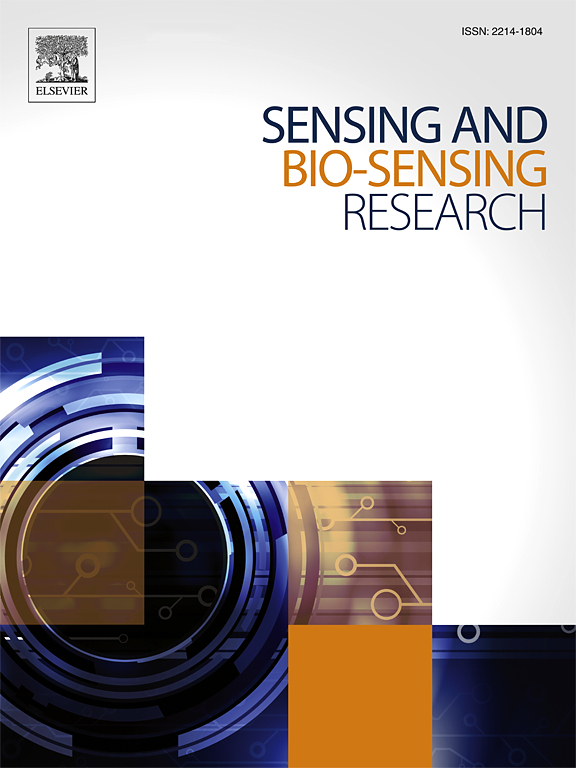Complementary split ring resonator sensors for dielectric characterization of liquids in biosensing applications
IF 4.9
Q1 CHEMISTRY, ANALYTICAL
引用次数: 0
Abstract
This study explores the design, optimization, and experimental validation of complementary split ring resonators (CSRR) for dielectric characterization of liquids, with a focus on biosensing applications. Six CSRR configurations featuring circular geometries with capacitance-enhancing modifications were evaluated. A particle swarm optimization algorithm was employed to maximize sensitivity, quality factor, and resonant peak magnitude. Experimental testing used saline solutions with varying bovine serum albumin concentrations, mimicking the electrical properties of blood. Among the designs, the Meandered Capacitance Single Ring (MC-SR) resonator emerged as the most effective, demonstrating high sensitivity and consistent results. Close alignment between simulations and experiments validated the sensor’s capability to detect subtle dielectric variations within the liquid under test across the 1.5–3 GHz range. Preliminary simulations indicate that the MC-SR CSRR achieves sufficient penetration depth to detect changes beneath skin and subcutaneous fat layers with a combined thickness of 1.5 mm. These findings highlight the potential of CSRR-based sensors for non-invasive biosensing applications, such as monitoring glucose levels and other blood analytes, by effectively addressing sensitivity challenges while only partially improving selectivity. Future efforts will aim to refine on-body sensing applications and enhance robustness in real-world scenarios, with a particular focus on overcoming selectivity limitations.
在生物传感应用中用于液体介电特性的互补分裂环谐振器传感器
本研究探讨了用于液体介质表征的互补分裂环谐振器(CSRR)的设计、优化和实验验证,重点是生物传感应用。评估了六种具有圆形几何形状的CSRR配置,并进行了电容增强修改。采用粒子群优化算法实现灵敏度、质量因子和共振峰量级的最大化。实验测试使用不同牛血清白蛋白浓度的生理盐水溶液,模拟血液的电学特性。在这些设计中,弯曲电容单环(MC-SR)谐振器表现出高灵敏度和一致性,是最有效的。模拟和实验之间的紧密一致性验证了传感器在1.5-3 GHz范围内检测被测液体中细微介电变化的能力。初步模拟表明,MC-SR CSRR达到了足够的穿透深度,可以检测皮肤和皮下脂肪层的变化,其总厚度为1.5 mm。这些发现强调了基于csrr的传感器在非侵入性生物传感应用中的潜力,例如监测血糖水平和其他血液分析,通过有效地解决敏感性挑战,而只是部分提高选择性。未来的努力将致力于改进身体传感应用,增强现实场景中的鲁棒性,特别关注克服选择性限制。
本文章由计算机程序翻译,如有差异,请以英文原文为准。
求助全文
约1分钟内获得全文
求助全文
来源期刊

Sensing and Bio-Sensing Research
Engineering-Electrical and Electronic Engineering
CiteScore
10.70
自引率
3.80%
发文量
68
审稿时长
87 days
期刊介绍:
Sensing and Bio-Sensing Research is an open access journal dedicated to the research, design, development, and application of bio-sensing and sensing technologies. The editors will accept research papers, reviews, field trials, and validation studies that are of significant relevance. These submissions should describe new concepts, enhance understanding of the field, or offer insights into the practical application, manufacturing, and commercialization of bio-sensing and sensing technologies.
The journal covers a wide range of topics, including sensing principles and mechanisms, new materials development for transducers and recognition components, fabrication technology, and various types of sensors such as optical, electrochemical, mass-sensitive, gas, biosensors, and more. It also includes environmental, process control, and biomedical applications, signal processing, chemometrics, optoelectronic, mechanical, thermal, and magnetic sensors, as well as interface electronics. Additionally, it covers sensor systems and applications, µTAS (Micro Total Analysis Systems), development of solid-state devices for transducing physical signals, and analytical devices incorporating biological materials.
 求助内容:
求助内容: 应助结果提醒方式:
应助结果提醒方式:


